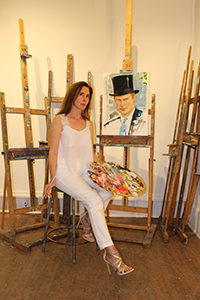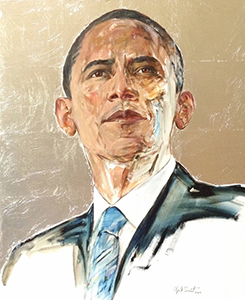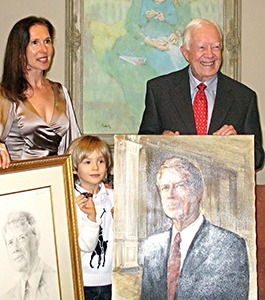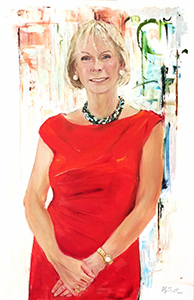ENTREPRENEUR’S CORNER
By Julian Sands

Olga Sweet believes that a portrait must first and foremost be tasteful. Her responsibility as a portraitist is to capture the likeness and expression that best reflect her subject’s character—and life story.
“I am fortunate to be in this profession.” she recently told us. “I feel an enormous responsibility to my clients to create a portrait they love, and that has artistic value,” the Moscow-born artist says. Her home is filled with portraits of various sizes; most are done in oil, but there are also graphite drawings that are just as beautiful and expressive.
Sweet, who studied at Moscow University during the turmoil of the last days of the Soviet Union, came to the U.S. to pursue her Ph.D. studies. “I fell in love with people’s faces. All our fears and loves are so clearly displayed in our faces. You just have to find the expression that really shows that,” she says.
How would you describe what you do as an entrepreneur?
I am in a fascinating business—painting people. Commissioning a portrait within a family is an expression of love. What better to give someone who has everything, than a portrait of a loved one? Many of my Manhattan clients await the portrait of their child with more anticipation than they await almost anything else, even jewelry! Portraits accentuate love.
 President Obama
President ObamaWhy did you choose to paint portraits?
I like painting many things in many different ways, but even more I really like people’s faces. Most of us are so transparent in showing our feelings and traits: it is fun to find that perfect way of describing the sitter. It is not easy, and sometimes I have to start over, to struggle—to decide never to paint again!—but eventually, I find the solution. The feeling that I created an image that is close to the real person—accomplished or not, young or old—is very gratifying. And no city is more fun for a painter than New York: it is hard to find a dull person in this town!
Is it true that the longer you paint, the better the portrait?
Not at all! An excellent portrait accentuates the sitter’s qualities, and it may take a sitting or two to find that turn of the head or pose, or the colors that describe him or her best. But the actual painting should be done quickly—or at least feel spontaneous and not “dusty,” not overdone.
How do you manage to be an artist and an entrepreneur?
It is hard. For many artists, painting is a consuming passion and thinking of marketing, bills, and other practical matters often feels like a burden. But you have to have discipline to be an entrepreneur: no way around it. Passion, yes, but also discipline. You have to find a buyer, to sell at least something to survive financially.
 Presenting to President Carter
Presenting to President CarterSo then it’s like running any other business?
Yes and no. If you cannot sell what you make, there is no point in making it. While that is The Rule in business, it is sometimes not true for artists. Many artists feel that they have to express something no matter what because it is so important to them, and often no one buys what they create. And, yes, sometimes once in a hundred years one is discovered, and one’s work sells for millions—but that borders on fairytales and unicorns. You make a choice. I have tremendous respect for artists who have the confidence to create something just for art’s sake.
How did you start and who was your first client?
I came to the U.S. from Russia on an International Research Exchange Scholarship (of Princeton). I had studied art and philosophy at Moscow University, which is one of the more extraordinary schools in the world. I then studied with one of the more phenomenal painters in the world, Ronald N. Sherr. My first client was an elderly countess from London, Mary Bagsster-Collins, who at the time lived in Millbrook, a magical place with gorgeous hills, fancy stables, fox hunting, and a rich history. While sitting for me, she told me stories of her life in London, including of her elegant house overlooking St. Paul’s Cathedral. She passed away a few days after our last sitting at the age of 99. Her relatives said they treasured the portrait more than any photographs of her.
 Dr. Frances Fergusson
Dr. Frances FergussonYou now have clients throughout the world. Do they all have something in common?
Yes: they all love art, love the tradition of portraiture. Also, they look for something unusual in a portrait, something new and unexpected. I love all my clients: I have never had a bad one.
Any funny stories to share with our readers?
Yes: of one of my favorite clients, Nacho Figueras. I delivered his portrait to the Bridgehampton Polo Club (which no longer exists). The game had not yet begun, and so we chatted as usual. Then, I unwrapped the portrait right then and there and gave it to him. Nacho said that it was “awesome” and—being a chivalrous man, like all Argentinian polo players—he nodded to kiss my hand symbolically. Not many American men have that habit, and I certainly did not expect it. It was only then that I remembered the large bandage across the back of my hand! But he was such a gentleman and said nothing.
Another memorable moment: When my eloquent and courageous six-year-old son started to teach President Carter how to distinguish a liar from an honest person—and President Carter thanked my William with great seriousness “for such good tips.” Then, there was the time I once spent three days agonizing over how best to wrap a Christmas present for a Duke: it had to be nothing less than perfect! And I think it was…
For more information on Olga Sweet, visit olgasweet.com.



